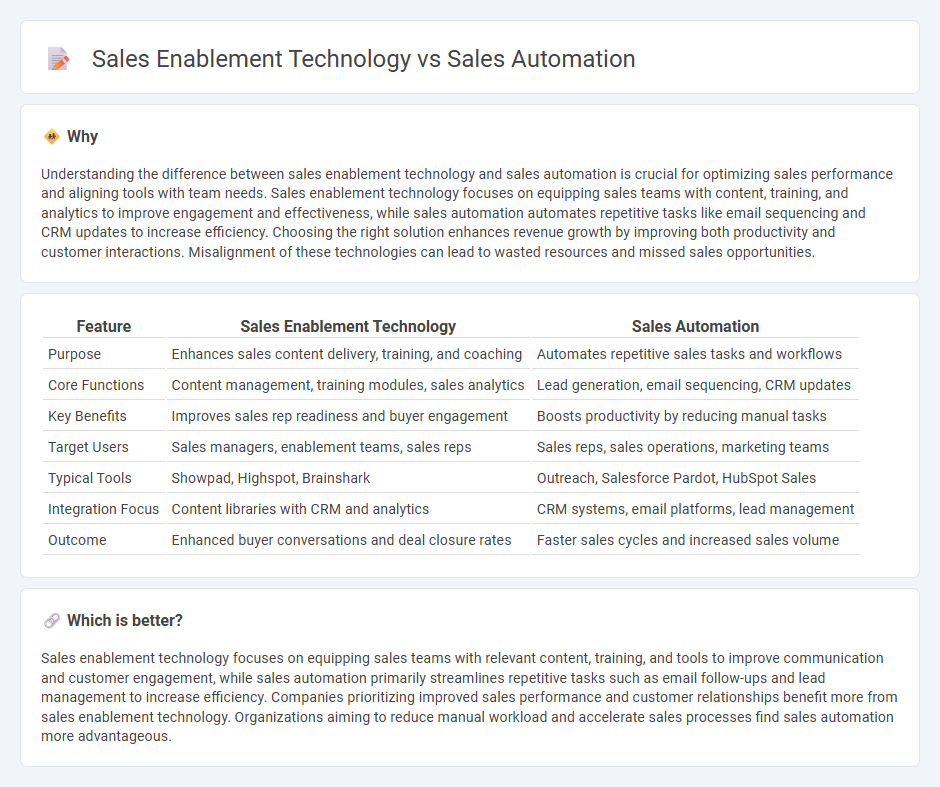
Sales enablement technology focuses on equipping sales teams with content, training, and tools to engage prospects effectively, while sales automation automates repetitive tasks such as email follow-ups and lead scoring to streamline workflows. Both systems improve sales efficiency but target different aspects of the sales process; enablement enhances skills and knowledge, whereas automation boosts productivity. Explore how integrating these technologies can transform your sales strategy and drive revenue growth.
Why it is important
Understanding the difference between sales enablement technology and sales automation is crucial for optimizing sales performance and aligning tools with team needs. Sales enablement technology focuses on equipping sales teams with content, training, and analytics to improve engagement and effectiveness, while sales automation automates repetitive tasks like email sequencing and CRM updates to increase efficiency. Choosing the right solution enhances revenue growth by improving both productivity and customer interactions. Misalignment of these technologies can lead to wasted resources and missed sales opportunities.
Comparison Table
| Feature | Sales Enablement Technology | Sales Automation |
|---|---|---|
| Purpose | Enhances sales content delivery, training, and coaching | Automates repetitive sales tasks and workflows |
| Core Functions | Content management, training modules, sales analytics | Lead generation, email sequencing, CRM updates |
| Key Benefits | Improves sales rep readiness and buyer engagement | Boosts productivity by reducing manual tasks |
| Target Users | Sales managers, enablement teams, sales reps | Sales reps, sales operations, marketing teams |
| Typical Tools | Showpad, Highspot, Brainshark | Outreach, Salesforce Pardot, HubSpot Sales |
| Integration Focus | Content libraries with CRM and analytics | CRM systems, email platforms, lead management |
| Outcome | Enhanced buyer conversations and deal closure rates | Faster sales cycles and increased sales volume |
Which is better?
Sales enablement technology focuses on equipping sales teams with relevant content, training, and tools to improve communication and customer engagement, while sales automation primarily streamlines repetitive tasks such as email follow-ups and lead management to increase efficiency. Companies prioritizing improved sales performance and customer relationships benefit more from sales enablement technology. Organizations aiming to reduce manual workload and accelerate sales processes find sales automation more advantageous.
Connection
Sales enablement technology integrates tools and content to streamline sales processes, enhancing team productivity and customer engagement. Sales automation leverages these technologies to automate repetitive tasks such as email outreach, lead scoring, and follow-ups, reducing manual effort and increasing efficiency. Together, they create a cohesive system that accelerates the sales cycle and improves conversion rates.
Key Terms
**Sales Automation:**
Sales automation streamlines repetitive sales tasks such as lead management, follow-ups, and CRM updates, boosting efficiency and allowing sales teams to focus on closing deals. Tools like Salesforce, HubSpot Sales, and Outreach automate workflows, reduce manual errors, and enhance pipeline visibility. Discover how sales automation can revolutionize your sales process and drive revenue growth.
CRM Integration
Sales automation technology streamlines repetitive tasks such as lead scoring and follow-up emails, enhancing productivity within CRM platforms like Salesforce and HubSpot. Sales enablement technology, integrated with CRMs, provides content management, training, and real-time insights that empower sales teams to engage prospects more effectively. Explore how CRM integration amplifies both sales automation and enablement to optimize your sales strategy.
Workflow Automation
Sales automation technology streamlines repetitive tasks such as lead scoring, email follow-ups, and pipeline updates to enhance sales team efficiency. Sales enablement technology focuses on providing sales reps with content, training, and tools that support effective buyer engagements and improve close rates. Explore how integrating workflow automation can optimize your entire sales process and maximize productivity.
Source and External Links
What is Sales Automation? | Salesforce US - Sales automation streamlines and updates the sales process from lead to close by using software, such as CRM, to automate contact management, prospecting, and opportunity management, ensuring data is current and next steps are clear for sales teams.
5 sales automation platforms to help teams close more deals in 2025 - Sales automation covers a range of workflows including pipeline management, order processing, and marketing alignment, using rules and AI to assign leads, update deal stages, process orders, and nurture prospects for higher conversion rates.
What is sales automation? - IBM - Sales automation leverages technologies like AI and RPA to eliminate repetitive tasks, improve efficiency, and increase productivity across the entire sales cycle, from lead generation to retention, while also enhancing collaboration between sales and marketing teams.
 dowidth.com
dowidth.com